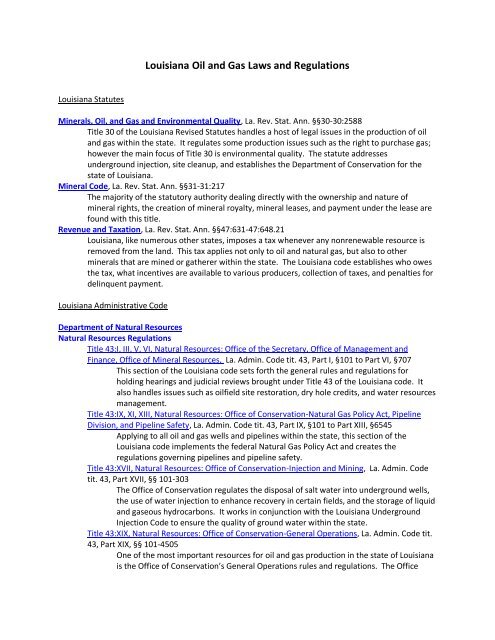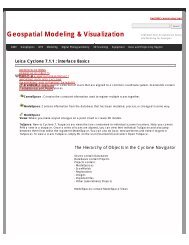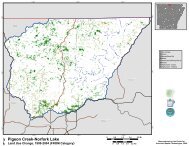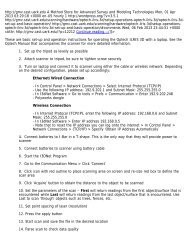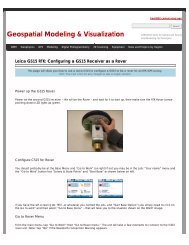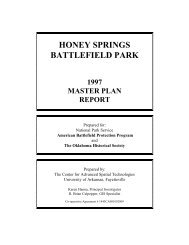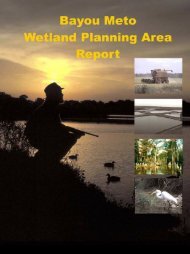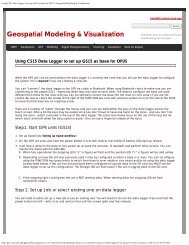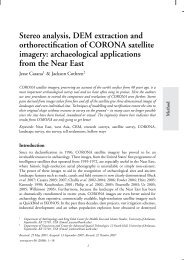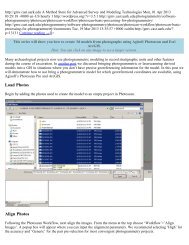Louisiana Oil and Gas Laws and Regulations - CAST
Louisiana Oil and Gas Laws and Regulations - CAST
Louisiana Oil and Gas Laws and Regulations - CAST
Create successful ePaper yourself
Turn your PDF publications into a flip-book with our unique Google optimized e-Paper software.
<strong>Louisiana</strong> <strong>Oil</strong> <strong>and</strong> <strong>Gas</strong> <strong>Laws</strong> <strong>and</strong> <strong>Regulations</strong><strong>Louisiana</strong> StatutesMinerals, <strong>Oil</strong>, <strong>and</strong> <strong>Gas</strong> <strong>and</strong> Environmental Quality, La. Rev. Stat. Ann. §§30-30:2588Title 30 of the <strong>Louisiana</strong> Revised Statutes h<strong>and</strong>les a host of legal issues in the production of oil<strong>and</strong> gas within the state. It regulates some production issues such as the right to purchase gas;however the main focus of Title 30 is environmental quality. The statute addressesunderground injection, site cleanup, <strong>and</strong> establishes the Department of Conservation for thestate of <strong>Louisiana</strong>.Mineral Code, La. Rev. Stat. Ann. §§31-31:217The majority of the statutory authority dealing directly with the ownership <strong>and</strong> nature ofmineral rights, the creation of mineral royalty, mineral leases, <strong>and</strong> payment under the lease arefound with this title.Revenue <strong>and</strong> Taxation, La. Rev. Stat. Ann. §§47:631-47:648.21<strong>Louisiana</strong>, like numerous other states, imposes a tax whenever any nonrenewable resource isremoved from the l<strong>and</strong>. This tax applies not only to oil <strong>and</strong> natural gas, but also to otherminerals that are mined or gatherer within the state. The <strong>Louisiana</strong> code establishes who owesthe tax, what incentives are available to various producers, collection of taxes, <strong>and</strong> penalties fordelinquent payment.<strong>Louisiana</strong> Administrative CodeDepartment of Natural ResourcesNatural Resources <strong>Regulations</strong>Title 43:I, III, V, VI, Natural Resources: Office of the Secretary, Office of Management <strong>and</strong>Finance, Office of Mineral Resources, La. Admin. Code tit. 43, Part I, §101 to Part VI, §707This section of the <strong>Louisiana</strong> code sets forth the general rules <strong>and</strong> regulations forholding hearings <strong>and</strong> judicial reviews brought under Title 43 of the <strong>Louisiana</strong> code. Italso h<strong>and</strong>les issues such as oilfield site restoration, dry hole credits, <strong>and</strong> water resourcesmanagement.Title 43:IX, XI, XIII, Natural Resources: Office of Conservation-Natural <strong>Gas</strong> Policy Act, PipelineDivision, <strong>and</strong> Pipeline Safety, La. Admin. Code tit. 43, Part IX, §101 to Part XIII, §6545Applying to all oil <strong>and</strong> gas wells <strong>and</strong> pipelines within the state, this section of the<strong>Louisiana</strong> code implements the federal Natural <strong>Gas</strong> Policy Act <strong>and</strong> creates theregulations governing pipelines <strong>and</strong> pipeline safety.Title 43:XVII, Natural Resources: Office of Conservation-Injection <strong>and</strong> Mining, La. Admin. Codetit. 43, Part XVII, §§ 101-303The Office of Conservation regulates the disposal of salt water into underground wells,the use of water injection to enhance recovery in certain fields, <strong>and</strong> the storage of liquid<strong>and</strong> gaseous hydrocarbons. It works in conjunction with the <strong>Louisiana</strong> UndergroundInjection Code to ensure the quality of ground water within the state.Title 43:XIX, Natural Resources: Office of Conservation-General Operations, La. Admin. Code tit.43, Part XIX, §§ 101-4505One of the most important resources for oil <strong>and</strong> gas production in the state of <strong>Louisiana</strong>is the Office of Conservation’s General Operations rules <strong>and</strong> regulations. The Office
creates <strong>and</strong> enforces many of the rules addressing numerous issues in the production ofoil <strong>and</strong> gas. The rules <strong>and</strong> regulations regarding pollution control, spacing of wells,storage of production waste, <strong>and</strong> the hearing procedures for adjudicating disputes thatarise are some of the primary issues regarding oil <strong>and</strong> gas production that this sectionaddresses.Department of Environmental QualityEnvironmental Regulatory CodeTitle 33:I, Environmental Quality: Office of the Secretary-Departmental AdministrativeProcedures, La. Admin. Code tit. 33, Part I, §§ 101-6925This section establishes the general rules <strong>and</strong> procedures for the operation of the<strong>Louisiana</strong> Department of Environmental Quality. It addresses notice requirements,procedural requirements for hearings, declaratory ruling procedures, <strong>and</strong> penalties foradministrative determinations. The regulations also address rulemaking requirements,permit requirements, permit application reviews, notification requirements, <strong>and</strong>emergency response regulations.Title 33:III, Environmental Quality: Air, La. Admin. Code tit. 33, Part III, §§ 101-5913The Air Quality program is administered under the <strong>Louisiana</strong> Department ofEnvironmental Quality with the purpose of maintaining the purity of the air resources ofthe state of <strong>Louisiana</strong> in a manner that is “consistent with the protection of the health<strong>and</strong> physical property of the people.” This section contains the rules <strong>and</strong> regulations onthe Air Quality Control Programs, permits, emissions <strong>and</strong> emission st<strong>and</strong>ards.Title 33:V, Environmental Quality: Hazardous Waste <strong>and</strong> Hazardous Materials, La. Admin. Codetit. 33, Part V, §§ 101-5311This section of regulation is intended to prevent damage to property or to theenvironment by the improper management of hazardous waste <strong>and</strong> to establish theminimum st<strong>and</strong>ards for the h<strong>and</strong>ling of hazardous waste in the state of <strong>Louisiana</strong>.Title 33:VI, Environmental Quality: Inactive <strong>and</strong> Ab<strong>and</strong>oned Hazardous Wastes <strong>and</strong> HazardousSubstance Site Remediation, La. Admin. Code tit. 33, Part VI, §§ 101-1119The regulation of ab<strong>and</strong>oned <strong>and</strong> inactive hazardous waste <strong>and</strong> hazardous substancesites is covered within this section. Functioning similar to the federal ComprehensiveEnvironmental Response, Compensation, <strong>and</strong> Liability Act (CERCLA or “Superfund”), thischapter deals with the administrative process of identifying ab<strong>and</strong>oned or inactive sites,determining the “potentially responsible parties,” site cleanup, settlements <strong>and</strong>negotiations, <strong>and</strong> the cost recovery associated with the cleanup of these sites.Title 33:IX, Environmental Quality: Water Pollution Control, La. Admin. Code tit. 33, Part V, §§101-7399The Department of Environmental Quality is tasked with protecting the waters of thestate of <strong>Louisiana</strong> through establishing requirements for water quality, permitsenforcement, monitoring, surveillance, <strong>and</strong> spill control activities.<strong>Louisiana</strong> Department of RevenueSeverance Tax <strong>Regulations</strong>, La. Admin. Code tit. 61, Part I, §§ 2901-2903The regulations on the <strong>Louisiana</strong> Severance Tax establishes what minerals <strong>and</strong> whatevents trigger the tax as well as the rates of taxation <strong>and</strong> the definitions of various termsused by both the industry <strong>and</strong> the <strong>Louisiana</strong> Department of Revenue.Federal Statutes
Federal Water Pollution Control Act (a/k/a Clean Water Act), 33 U.S.C. §§ 1251-1387The Clean Water Act serves as the primary federal law regulating surface water pollution in theUnited States. The scope of this statute is extended to oceans, rivers, lakes, streams, wetl<strong>and</strong>s,sloughs, <strong>and</strong> intermittent streams that have a “significant nexus” to “navigable waters”; whichhas been broadly interpreted by the courts. Waters that fall within this definition have qualityst<strong>and</strong>ards assigned to them by the EPA <strong>and</strong> many individual states so that each body of water ofwater has a Total Maximum Daily Load (TMDL) of pollutants that the water can h<strong>and</strong>le with nofurther degradation. The term "pollutant" is broadly defined <strong>and</strong> includes heat, waste, soil,rock, chemical materials, <strong>and</strong> biological materials. Once a TMDL has been adopted for a body ofwater, then permits will be issued either by the EPA, or by the states that are qualified under theEPA, to allow for the discharge of recognized pollutants. This permitting process is called theNational Pollutant Discharge Elimination System (NPDES) <strong>and</strong> it requires “point sources” ofpollution (oil <strong>and</strong> gas extraction is considered a point source) to acquire the permit <strong>and</strong> keeptheir discharge below the level required. Failure to comply with the Clean Water Act can lead tosignificant penalties of up to $25,000 dollars per day for a first violation <strong>and</strong> $50,000 per day forsubsequent violations along with imprisonment for up to fifteen years for knowinglyendangering people through the unlawful discharge of pollutants.Federal Air Pollution <strong>and</strong> Control Act (a/k/a Clean Air Act), 42 U.S.C. §§ 7401-7671qThe Clean Air Act seeks to protect human health <strong>and</strong> the environment from emissions thatpollute ambient, or outdoor, air. It requires the EPA to establish minimum national st<strong>and</strong>ards forair quality, <strong>and</strong> assigns primary responsibility to the states to assure compliance with thest<strong>and</strong>ards. Areas not meeting the st<strong>and</strong>ards, referred to as nonattainment areas, are required toimplement specified air pollution control measures. The CAA establishes federal st<strong>and</strong>ards formobile sources of air pollution, for sources of 188 hazardous air pollutants, <strong>and</strong> for theemissions that cause acid rain. Further, it establishes a comprehensive permit system for allmajor sources of air pollution.Comprehensive Environmental Response, Compensation, <strong>and</strong> Liability Act, 42 U.S.C. §§ 9601-9675Also known as “Superfund,” this is the federal statute that deals with discharges of hazardouswaste into the environment by "potentially responsible parties." Administered by the EPA, itprovides a Federal "superfund" to clean up uncontrolled or ab<strong>and</strong>oned hazardous-waste sites aswell as accidents, spills, <strong>and</strong> other emergency releases of pollutants <strong>and</strong> contaminants into theenvironment. Potentially responsible parties who can be identified bear the burden of the cleanupcosts under joint <strong>and</strong> several liability. For ab<strong>and</strong>oned sites, or those where responsibilitycannot be established, CERCLA created a fund to clean up ab<strong>and</strong>oned hazardous waste sites.Safe Drinking Water Act, 42 U.S.C. §§ 300f - 300j-26This act was passed to ensure that the general public would have safe drinking water availableto them. The SDWA applies to every public water system in the United States, but does notapply to private water wells. The act sets “maximum contaminant levels” which must be met<strong>and</strong> maximum contaminant level goals” for all contaminants. To protect public drinking waterthe EPA was authorized to regulated underground injection wells through the UndergroundInjection Control Program, 40 C.F.R. §§ 144.1-144.89.Natural <strong>Gas</strong> Act, 15 U.S.C. §§ 717-717zThe Natural <strong>Gas</strong> Act regulates the transmission <strong>and</strong> selling of natural gas across state lines. Italso regulates the construction, extension or ab<strong>and</strong>onment of facilities, record keepingrequirements, <strong>and</strong> sets the administrative process to h<strong>and</strong>le violations <strong>and</strong> enforcement.Endangered Species Act, 16 U.S.C. §§ 1531-1544The Endangered Species Act (ESA) protects species identified as endangered or threatened withextinction <strong>and</strong> attempts to protect the habitat on which they depend. It is administered
primarily by the Fish <strong>and</strong> Wildlife Service <strong>and</strong> also by the National Marine Fisheries Service, forcertain marine creatures. Dwindling species are listed as either endangered or threatenedaccording to assessments of the risk of their extinction. An endangered species is defined as"any species which is in danger of extinction throughout all or a significant portion of itsrange...." A threatened species is as "any species which is likely to become an endangeredspecies within the foreseeable future throughout all or a significant portion of its range." TheSecretary of the Interior decides to list the species based on the "best available" scientific <strong>and</strong>commercial information, after a series of procedural steps to ensure public participation. Oncea creature is listed as endangered or threatened, its "taking" is prohibited under 16 U.S.C. §1538. To "take," under the ESA, means "to harass, harm, pursue, hunt, shoot, wound, kill, trap,capture, or collect, or to attempt to engage in any such conduct." After a species is listed asthreatened or endangered, the Secretary of the Interior must also designate critical habitat,which is either where the species is found or, if it is not found there, where there are featuresessential to its conservation. Once the habitat is identified, special protections are put into placefor the area as well as the creature.Federal <strong>Regulations</strong> <strong>and</strong> OrdersU.S. Army Corps of Engineers Clean Water Act <strong>Regulations</strong>, 33 C.F.R. §§ 320; 323-338The U.S. Army Corps of Engineers shares authority under the Clean Water Act along with theEnvironmental Protection Agency. This section of regulations governs what responsibilities theCorps has along with the policies <strong>and</strong> procedures that they use.Department of the Interior Minerals Management, 43 C.F.R. §§ 3000-3873.3The United States Government is the largest l<strong>and</strong>owner in the country <strong>and</strong> controls about 30%of the l<strong>and</strong>. In Arkansas, the federal government has significant holdings in the western half ofthe state including some l<strong>and</strong> in the Fayetteville Shale. The Department of the Interior managesthe mineral issues that arise throughout the country on federal l<strong>and</strong> <strong>and</strong> these regulationsgovern how the federal government will deal with the various parties in the exploration, leasing,drilling, <strong>and</strong> recovery of minerals on federal l<strong>and</strong>s.Environmental Protection Agency<strong>Oil</strong> <strong>and</strong> <strong>Gas</strong> Extraction Point Source Category, 40 C.F.R. §§ 435.10-435.70These EPA regulations <strong>and</strong> guidelines concerning the use of technology <strong>and</strong> technologicalrequirements were introduced to reduce the impact of oil <strong>and</strong> gas wells on the surroundingenvironment.Clean Air Act <strong>Regulations</strong>, 40 C.F.R. §§ 1-99The purpose of the Clean Air Act is to protect human health <strong>and</strong> the environment fromemissions that pollute ambient, or outdoor, air. The Clean Air Act establishes the authority ofthe EPA to create regulations <strong>and</strong> procedures to carry out this goal. These regulations work with<strong>and</strong> supplement the CAA by setting out exactly the procedures, thresholds, reportingrequirements, <strong>and</strong> minimum compliance st<strong>and</strong>ards for air quality.Water Programs <strong>Regulations</strong>, 40 C.F.R. §§ 100-149The Water Programs <strong>Regulations</strong> are administered EPA with the intended goal of protectingwater quality by regulating the discharge of pollutants, including oil <strong>and</strong> gas, establishingguidelines to test water quality, enforcing national drinking water regulations, administer theUnderground Injection Control (UIC) Program, <strong>and</strong> set state st<strong>and</strong>ards for their UIC programs.Superfund, Emergency Planning <strong>and</strong> Community Right-to-Know Programs <strong>Regulations</strong>,40 C.F.R. §§ 300-374
Drafted <strong>and</strong> enforced by the EPA, these regulations implement CERCLA (better known asSuperfund) which holds polluters (called “potentially responsible parties”) financiallyresponsible for polluted sites that they are responsible for. It also funds site cleanup forab<strong>and</strong>oned sites where either the polluter is unknown or if they are no longer in business.Underground Injection Control Program, 40 C.F.R. §§ 144.1-144.89State Underground Injection Control Program Requirements, 40 C.F.R. §§ 145.1-144.58Underground Injection Control Program: Criteria <strong>and</strong> St<strong>and</strong>ards, 40 C.F.R. §§ 146.1-144.73State Underground Injection Control Programs, 40 C.F.R. §§ 147.1-144.3109Hazardous Waste Injection Restrictions, 40 C.F.R. §§ 148.1-144.24Congressional Research Service Reports?Other Government Resources<strong>Louisiana</strong> Department of Natural ResourcesOffice of Mineral ResourcesOrphan Wells by ParishGround Water Resources ProgramHaynesville Shale InformationWell Evaluation ChecklistWater Well Notification FormDepartment of Natural Resources: <strong>Louisiana</strong> Office of ConservationSONRIS – Database for <strong>Oil</strong> & <strong>Gas</strong> Drilling/Production InformationOffice of Conservation – <strong>Oil</strong>field Site Restoration SectionCommercial E&P Waste Facility Permit ApplicationFormsOperator's Monthly <strong>Oil</strong> <strong>and</strong> <strong>Gas</strong> ReportTransporter's <strong>and</strong> Storer's Monthly ReportRefiner's Monthly ReportOperator's Monthly <strong>Gas</strong> Disposition ReportNatural <strong>Gas</strong> Transporter's Monthly ReportPart 1 Continuation Form (for R2, R3, R5T TAS Reports)<strong>Oil</strong> <strong>and</strong> <strong>Gas</strong> Import/Export Summary<strong>Gas</strong> Well Deliverability Test<strong>Gas</strong> Well Deliverability Test (instructions)<strong>Oil</strong> Well Potential Report<strong>Oil</strong> Well Potential Report (instructions)L<strong>and</strong>owner Affidavit of No Objection for Passive Pit ClosurePerformance Bond (1 Well)Performance Bond (Multiple Wells)Irrevocable Letter of Credit (1 Well)Irrevocable Letter of Credit (Multiple Wells)Pledge of Certificate of Deposit (1 Well)Pledge of Certificate of Deposit (Multiple Wells)Blanket – 10 Wells
Blanket – 25 WellsMulti-Well - By Footage<strong>Oil</strong>field Site Restoration Contractors ApplicationOrganization Report TransportersOrganization Report OperatorsPlug <strong>and</strong> Ab<strong>and</strong>on ReportOperators Certificate of Compliance <strong>and</strong> Authorization to Transport <strong>Oil</strong> From ProductionFacilitySeverance Tax Relief Program form for Inactive WellSeverance Tax Relief Program form for New Reservoir DiscoverySeverance Tax Relief Program form for Wells Deeper than 15,000 ft. T.V.D.Severance Tax Relief Program form for Wells Drilled with an 80 degree or greater holdfor 50 feet or moreSeverance Tax Relief Program form to apply 3D costs to a number of wellsOffice Policy Memos for the Severance Tax Relief Program (STRP)Site Specific Trust Account FormSite Specific Trust Account ReassessmentEnhanced Recovery Annual Data SheetEnhanced Recovery QuestionnaireSite Clearance VerificationE & P Waste Containment Structure NotificationExploration & Production Waste Unauthorized Discharge/Disposal Notification<strong>Oil</strong>field Waste DispositionInactive Well ReportApparent DeviationPotential ReportClass-I Injection Well ApplicationClass - II Injection Well ApplicationClass-II EOR ApplicationClass-II Hydrocarbon Storage Well ApplicationClass-II Commercial Injection Well ApplicationClass-II Commercial Slurry Fracture Injection Well ApplicationClass III Brine Extraction Well ApplicationClass-II Well Integrity AffidavitClass-I Well Integrity AffidavitAnnular Saltwater Disposal Well ApplicationAnnual Disposal/Injection Well Monitoring ReportMechanical Integrity Noncommercial Class II Daily Monitor LogCommunity Saltwater Disposal System Initial NotificationApplication for Annular Disposal of Reserve Pit FluidsInjection Well Work PermitCom. Facility Monthly Report of Waste ReceiptsCommercial Class II Daily Monitor LogRequest to Transport E&P Waste to Commercial Facilities or Transfer StationsClass I Quarterly ReportClass V Well ApplicationWaste Refusal NotificationExploration <strong>and</strong> Production Waste Shipping Control Ticket
Authorization for After Hours Disposal of NOWWork permit to Plug & Ab<strong>and</strong>on a Well utilized for NORM disposalApplication to Change Disposal/Injection ZoneClass III Quarterly Report (Form QR-3)Class III Daily Pressure Monitor Log (Form MIT-3)Injection Pressure & Rate Monitoring LogClass V Well History <strong>and</strong> Work Resume ReportE&P Waste Disposal in a Salt CavernRadioactive Tracer Guidelines <strong>and</strong> Procedures for Annular Disposal of Pit FluidsRadioactive Tracer Guidelines <strong>and</strong> Procedures for Annular Saltwater Disposal WellsRadioactive Tracer Guidelines <strong>and</strong> Procedures for Disposal Wells Completed with Tubing<strong>and</strong> PackerRadioactive Tracer Guidelines <strong>and</strong> Procedures for Packerless Disposal WellsTime Drive SupplementRadioactive Tracer Log SheetOrganizational ReportPlug <strong>and</strong> Ab<strong>and</strong>on ReportWell History <strong>and</strong> Work Resume ReportAffidavit of Test of Casing in WellPublic Notice Requirements for Applications for Solution-Mined Salt Caverns,Hydrocarbon Storage in a Solution-Mined Salt Cavern, <strong>and</strong> Associated Saltwater DisposalWellsEstimated Economic Impact StatementPipelinesFailure Investigation ReportNotice of ConstructionOperator Qualification Inspection FormOperator Qualification ProtocolsOQ Protocol 9 Field Inspection FormPipe Data <strong>and</strong> Operating Stresses FormAnnual Report FormAnnual Report Form InstructionsIncident Report FormIncident Report Form InstructionsOQ Guide for Small Distribution SystemsAnnual Report FormAnnual Report InstructionsIncident Report FormIncident Report InstructionsAccident Report FormAccident Report Form InstructionsAnnual Report Form (federal form)Annual Report Form Instructions (federal form)Annual Report Form (state form)Integrity Management Inspection Form (small operators)PLS-OR-1 Organization ReportApplication for Ab<strong>and</strong>onment of FacilitiesApplication for Ab<strong>and</strong>onment of Services
Application for Approval to Interconnect PipelinesBrief of Contract for Intrastate Natural <strong>Gas</strong>Expedited Notice - Contract for Intrastate Natural <strong>Gas</strong>Application for Construction, Acquisition or Replacement of Facilities<strong>Louisiana</strong> Department of Environmental Quality<strong>Louisiana</strong> Tax CommissionSeverance Tax Policy DocumentsBureau of L<strong>and</strong> ManagementForms <strong>and</strong> Orders for Onshore <strong>Oil</strong> <strong>and</strong> <strong>Gas</strong> Operations on Federal L<strong>and</strong>sOnshore <strong>Oil</strong> <strong>and</strong> <strong>Gas</strong> Geophysical Exploration Surface Management RequirementsIssuance of LeasesLeasing Under Special ActsLeasing TermsEnvironmental Protection Agency (EPA)Exemption of <strong>Oil</strong> <strong>and</strong> <strong>Gas</strong> Exploration <strong>and</strong> Production Wastes from Federal Hazardous Waste<strong>Regulations</strong> (2002)Emergency Management – <strong>Oil</strong> SpillsProfile of the <strong>Oil</strong> <strong>and</strong> <strong>Gas</strong> Extraction IndustryImpaired Waters <strong>and</strong> Total Maximum Daily Loads“Waters of the United States” under the CWAWetl<strong>and</strong>sDepartment of EnergyFederal Policy <strong>and</strong> Guidance DocumentsFish <strong>and</strong> Wildlife ServiceDigest of the Federal Water Pollution Control Act (Clean Water Act)Endangered Species ProgramListed SpeciesPermitsOther ResourcesClean Water Act Jurisdictional H<strong>and</strong>book (Environmental Law Institute, 2007)<strong>Oil</strong> <strong>and</strong> <strong>Gas</strong> Leases<strong>Louisiana</strong> <strong>Oil</strong> & <strong>Gas</strong> Association<strong>Louisiana</strong> Mid-Continent <strong>Oil</strong> <strong>and</strong> <strong>Gas</strong> Association<strong>Louisiana</strong> Severance Tax Overview


